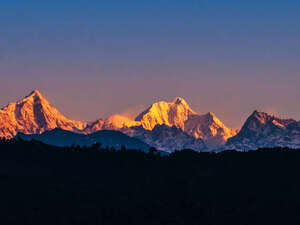Kanchenjunga Height: A Majestic Mountain and Its Significance
Body
Kanchenjunga, the third-highest mountain in the world, stands tall at an impressive 8,586 meters (28,169 feet) above sea level. Located in the eastern Himalayas, Kanchenjunga lies on the border between Nepal and the Indian state of Sikkim. Known for its grandeur, the mountain holds immense cultural, spiritual, and geographical significance. The Kanchenjunga height not only makes it a prominent feature of the Himalayas but also a focal point of natural beauty and adventure.
In this article, we will delve into the Kanchenjunga height, its unique characteristics, the challenges it presents to mountaineers, its cultural importance, and how it stands as a symbol of pride for the region. We will also look at its sub-peaks and how the mountain contributes to the landscape of the eastern Himalayas.
Understanding the Kanchenjunga Height and Its Importance
At 8,586 meters (28,169 feet), Kanchenjunga ranks as the third-highest mountain on Earth, following Mount Everest (8,848 meters) and K2 (8,611 meters). This height places it among the giants of the world’s tallest peaks, making it a sought-after destination for mountaineers, trekkers, and nature lovers alike. Its name, Kanchenjunga, comes from the Tibetan language, where "Kangchen" means "snow" and "Dzönga" means "five," referring to the five main peaks of the mountain range.
Kanchenjunga’s towering height and snow-capped peaks make it one of the most majestic mountains in the world. The mountain is surrounded by a network of glaciers and is known for its challenging terrain. The peaks and ridgelines of Kanchenjunga are often shrouded in clouds, adding to its mystique.
The importance of Kanchenjunga height goes beyond just being a geographical feature. The mountain plays a crucial role in the region’s climate, ecology, and tourism. It also holds religious significance for the local communities in both Nepal and India, particularly the people of Sikkim, where the mountain is revered as a sacred peak.
The Kanchenjunga Range and Its Five Main Peaks
Kanchenjunga is not just one single peak; it is a part of a range of peaks that rise dramatically from the surrounding landscape. The mountain has five prominent peaks, each contributing to the Kanchenjunga height and its grandeur. These five peaks are:
-
Kanchenjunga Main (8,586 meters / 28,169 feet): This is the highest and most well-known peak of the range and the third-highest mountain in the world.
-
Kanchenjunga West (8,505 meters / 27,906 feet): Also known as Yalung Kang, this peak is the second highest in the range.
-
Kanchenjunga Central (8,479 meters / 27,889 feet): This peak is located between the main peak and Kanchenjunga West.
-
Kanchenjunga South (8,494 meters / 27,867 feet): This peak is situated to the south of the main peak.
-
Kanchenjunga Lhotse (8,150 meters / 26,742 feet): This smaller peak is located at the southeastern end of the range and is sometimes referred to as the Lhotse Peak.
The Kanchenjunga height is collectively represented by these five peaks, each of which contributes to the mountain’s overwhelming presence. The massive range spans over 40 kilometers in length, with glaciers and valleys that enhance the beauty and mystique of the mountain.
The Geography and Terrain of Kanchenjunga
The Kanchenjunga range is located in the eastern Himalayas, specifically on the border between Nepal and Sikkim in India. The range is part of the larger Himalayan mountain system, which extends from the west in Pakistan through India, Nepal, Bhutan, and into Tibet.
Kanchenjunga’s glaciers, deep valleys, and rugged terrain present a challenging environment for trekkers and mountaineers. The Kanchenjunga Glacier, located to the north of the main summit, feeds into the Teesta River, which is a major river of Sikkim. The region is home to several glacial lakes, snowfields, and icefalls, adding to its dramatic beauty.
The geography surrounding Kanchenjunga is also rich in biodiversity. The forests and valleys at lower elevations are home to a variety of flora and fauna, including the red panda, snow leopard, and Himalayan tahr. The higher altitudes are largely barren, with little vegetation, but the glaciers and snowfields provide an awe-inspiring landscape.
Kanchenjunga: A Mountaineer's Dream and Challenge
Climbing Kanchenjunga is one of the most difficult and dangerous feats in mountaineering. The Kanchenjunga height and its steep slopes present extreme challenges, both for experienced climbers and for those seeking adventure. It is considered one of the most technically challenging climbs, with high winds, freezing temperatures, and unpredictable weather conditions.
Kanchenjunga was first summited in 1955 by a British expedition team led by Joe Brown and George Band. They made the historic ascent via the South East Ridge, which is one of the most popular routes. However, Kanchenjunga’s summit is considered sacred by the locals, and there is a traditional practice of not reaching the very top in respect to its spiritual significance. In fact, climbers are often advised to stop just short of the summit to honor the mountain's sacred status.
Over the years, several expeditions have attempted to climb the peak, but the harsh conditions, including avalanches, deep snow, and the high-altitude environment, have made the mountain notorious for its difficulty. The Kanchenjunga height combined with unpredictable weather, winds, and extreme cold makes it a dangerous climb for even the most experienced mountaineers.
Kanchenjunga’s Cultural and Spiritual Significance
For the people of Sikkim and Nepal, Kanchenjunga holds significant spiritual and cultural importance. The mountain is revered by the indigenous communities, and many consider it a sacred entity. In the local Lepcha and Bhutia cultures, Kanchenjunga is considered the home of the Dharma Raja, or King of the Law, a spiritual deity.
The people of Sikkim believe that the mountain's height and imposing presence are symbols of divine protection and blessing. Many local rituals and festivals are centered around the reverence of the mountain, with offerings made to Kanchenjunga to ensure the well-being of the community.
In Nepal, the mountain is known as Kanchenjunga Himal and is also seen as a sacred peak, with local deities believed to inhabit the region. The mountain is a focal point for religious and cultural practices, with many temples and shrines built in its honor.
Kanchenjunga and Tourism
While Kanchenjunga height and the mountain’s challenging terrain make it a difficult destination for climbing, the region surrounding the mountain is a popular destination for trekkers and nature enthusiasts. The Kanchenjunga Base Camp Trek is one of the most sought-after treks in the region, offering stunning views of the mountain range and an opportunity to explore the surrounding forests, villages, and remote areas.
The trek to Kanchenjunga Base Camp is a multi-day adventure that takes trekkers through picturesque landscapes, crossing high mountain passes and deep valleys. The trek also offers the chance to witness the unique culture of the local communities living in the region.
For those who want to experience the beauty of Kanchenjunga without the risks of high-altitude climbing, trekking and sightseeing in the surrounding areas offer a safe and fulfilling experience.
Conclusion
The Kanchenjunga height of 8,586 meters makes it one of the tallest mountains in the world and a prominent feature of the eastern Himalayas. Its grandeur, beauty, and significance, both in terms of geography and culture, make it an awe-inspiring sight. Whether you are an avid mountaineer, a trekking enthusiast, or someone interested in experiencing the spiritual and natural beauty of the region, Kanchenjunga has something to offer.
Its towering peaks and challenging weather conditions are not only a test of human endurance but also a symbol of the mountain's spiritual importance to the local people. With its breathtaking views, unique biodiversity, and cultural richness, Kanchenjunga remains one of the most revered and remarkable mountains in the world.













Comments